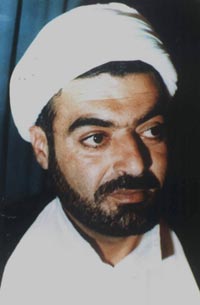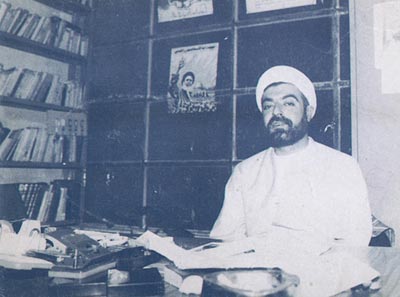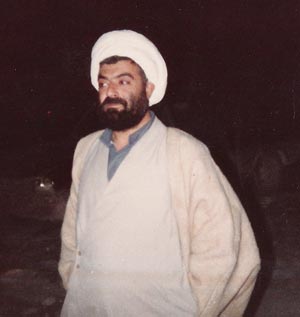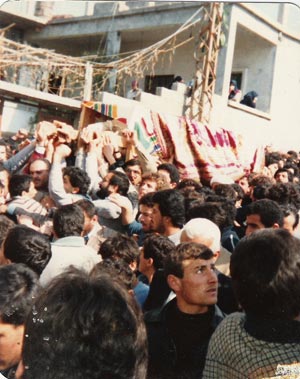Sheikh Ragheb Harb: A position is a Weapon and a Hand Shake is an Acknowledgment

Biography

Birth and Childhood
(Sheikh) Ragheb Harb was born in 1952 in the southern town of "Jibsheet" to two hard working parents who were distinguished their strong bonding to Islamic principles. During his childhood young Ragheb wasn't quite interested in entertainment like most of his peers. At the age of seven he enrolled in an elementary public school in "Jibsheet", and later went to the city of "Nabatiyeh" to continue his middle-school education, after which he left school to pursue his childhood dream, religious studies.
Moving to Beirut
In 1969, young Ragheb Harb, now 17, left his home town for Beirut, the capital. In the big city he pursued his religious studies; meeting numerous clerics and learning from them, and even joining their discussion groups. The close-knit circle he joined took part in many ceremonies and activities, increasing the young cleric's enthusiasm and interest. A year after he joined Islamic activism, he started looking forward to completing his studies at the Islamic Hawza (religious school) in the holy city of "Al-Najaf" in Iraq.
At the holy City of "Al-Najaf"
Sheikh Ragheb Harb lived at the schools of the holy city of "Al-Najaf" where he studied under the supervision of it's great masters, preparing himself to work at the service of the Islamic message .The cleric (Sheikh) Ragheb returned to Lebanon to visit his parents and friends ,then went back to "Al-Najaf "to complete his studies ,but this time he only stayed there for one and a half years due to the suppression of the Iraqi regime at the time against the clerics. So he came back in 1974 .

Back to "Jibsheet"
He went back to his home town realizing that his path was not a bed of roses. He knew that his road was going to be hard and long ,and it required much effort ,so he headed towards reforming what the state of affairs had ruined, and worked on portraying Islam in its crystal clear image through his preaching and the lectures he used to give. Sheikh Ragheb Harb was able to gather people around him through his magnetic approach. After he became confident of the awareness which he established among the people in his hometown, he wanted to go beyond the border of his tiny village, increasing the parameters of his work to include surrounding villages. So he started to communicate with their residents, sharing their concerns. This led to the successful establishment of the "Sayedah Zeinab" Islamic school under his patronage.
His social activities
Speaking of the experience of the cleric of the martyrs in the field of social work, we have to read clearly the method of thinking of the martyr, the cleric, which was distinguished in his character, and had a unique insight. He was working in pretty complicated circumstances, but he managed to achieve substantial success. And, probably, the most prominent social project that the martyr established was "the treasury of the Muslims" attributed to end poverty that prevailed in the villages of the south, which was directly influenced by the famine and deprivation policy applied by the political authority back then.
Sheikh Harb strived to establish "the treasury of the Muslims" that gave small loans to pious people, ranging between one hundred pounds to five hundred pounds per person as a minimum average.
These simple loans helped solve many financial problems in large sections of the pious community.
Establishing "Al Sharkieh" school
Given the fact that he moved to live in the town of "Al Sharkieh" which is 8 km from "Nabatiyeh", and under the wishes of a number of believers in that village, the cleric saw that it was necessary to build an elementary school for the kids of the village. He helped dig the foundations of the new site using the shovel; within a short period of time he completed the construction of a two story school on a piece of land belonging to the treasury board.
The Martyr Foundation
As the war in Lebanon went on, the "Israeli" occupation amplified the social and political devastation, leaving behind hundreds of martyrs and thousands of homeless people.
In this grim climate, the Martyrs Foundation was launched in Lebanon. It became a foundation which Sheikh Harb played a prominent role in creating. By the year 1978, the influence of the Islamic revolution in Iran surpassed all borders, and the cleric "Sheikh" Ragheb stayed a supporter to the causes of the revolution and its noble objectives, defending it strongly wherever he was until the very last moment of his life.
The stages of the confrontations with the Zionist occupation

Early in the month of June in 1982, the enemy invaded Lebanon, engulfing it in fire, destroying all barriers that stood in its way amidst an international conspiracy and Arab silence. At the time, Sheikh Ragheb Harb was not living in south Lebanon; he was attending an Islamic conference in the Islamic republic; it was there that he heard the news about the invasion and the occupation's violation of the South. This affected him deeply. He immediately decided to go back to take his place in the confrontation. After his arrival, he discovered there was a little done in the evening, so he called on people to
go to the mosque for prayers in defiance of the occupation. He resumed holding Friday prayers, even under the nozzles of the Zionists. Those prayers were filled with heroism,
challenge and pride.
The first confrontation
The cleric (Sheikh) Ragheb Harb proclaimed his refusal to communicate with the "Israeli"
enemy or cooperate in any form with it, calling upon the "Israeli" agents to drop their weapons and come back to their parents. One of his famous quotes was "A position is a Weapon and a Hand Shake is an Acknowledgement." And so he never shook hands with the Zionists.
One day the cleric was sitting on the roof of his house with some friends when he saw them approaching him, so he yelled at them to back off, but they didn't comply, and they proceeded until they walked up to him. One of the occupation officers put out his arm to shake hands with the sheikh. But the Sheikh Ragheb refused to comply. Sheikh Ragheb realized that from that time he was being followed and would be arrested at any time; therefore, he had to calculate every move.
Enemy breaks into Sheikh's house
As it was expected, the heavily-armed Zionist troops broke into his house many times. The most significant break-in was in December of 1982, but they failed to find him. The enemy was aware of the movement of the cleric due to the spies and agents that were on the lookout for him to locate his place. On march 8th , 1983, after midnight , a large  "Israeli" unit broke into the house he staying in, taking the cleric blindfolded to the intelligence headquarter near the village of " zebdeen" "south of Lebanon", and was later moved to the infamous "Anssar" concentration camp, and after that to the intelligence headquarter in Tyre city.
"Israeli" unit broke into the house he staying in, taking the cleric blindfolded to the intelligence headquarter near the village of " zebdeen" "south of Lebanon", and was later moved to the infamous "Anssar" concentration camp, and after that to the intelligence headquarter in Tyre city.
After his arrest, the people of the town took to the streets, and then they headed to "Al-Husseniyah" hall and called for an open protest until his release. The occupation forces had to release him under the intensely mounting pressure the uprising of the people created. At that raging stage of the conflict, the resistance operations of Muslim fighters intensified, teaching the enemy hard lessons. The cleric was the leader of the resistance at the time, and the occupation wanted him dead.
And so it was. On February 16th, on a Friday night in 1984, he was assassinated by "Israeli" enemy agents.

![Hezbollah Mourns 16 Martyrs on the Path of Liberating Al-Quds [20/9/2024]](https://english.alahednews.com.lb/uploaded2/images/20240921160501.jpg)
![Hezbollah Mourns 3 Martyrs on the Path of Liberating Al-Quds [20/9/2024]](https://english.alahednews.com.lb/uploaded2/images/20240921144707.jpg)

![Hezbollah Mourns 5 Martyrs on the Path of Liberating Al-Quds [19/9/2024]](https://english.alahednews.com.lb/uploaded2/images/20240920100136.jpg)